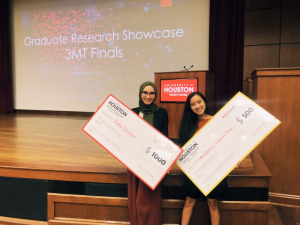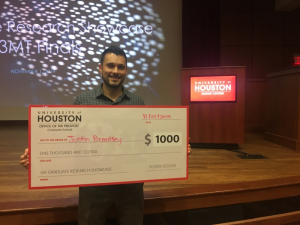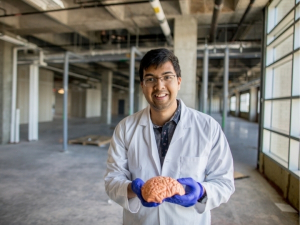UH graduate students inspire each other with accomplishments
Graduate students representing the UH Cullen College of Engineering shone bright in the university-wide Graduate Research Showcase hosted Nov. 1, 2019 by the UH Graduate School and the Office of the Provost. Students pursuing master’s degrees and Ph.D.s across all disciplines exhibit their research projects, network with peers and compete to receive awards and scholarships for their work.
“The Graduate Research Showcase provides students with a valuable opportunity to present their research and to hone their communication skills,” said Sarah C. Larsen, vice provost and dean of the Graduate School. “It is so impressive to see the breadth of exciting research being conducted by UH graduate students.”
Sharing research accomplishments serves as inspiration for more. “Students have commented that they benefit not only from presenting their research but from hearing about other student’s research projects,” Larsen added.
Several of the top prizes went to engineering graduate students and the Cullen College’s Department of Biomedical Engineering had an especially good showing.
3MT Awards
In the Three Minute Thesis (3MT) competition, Dalia Lezzar won first place and $1,000 with her presentation titled “Out with bad cells, in with the good;” and Madeleine Lu tied for third place with a student from the School of Social Work and won $500 with her entry titled “Tools for sticky situations: Developing tools for monitoring patients with blood disorders.”
Both Lezzar and Lu are pursuing their Ph.D.s in biomedical engineering and work in the UH Blood Microfluidics Laboratory. Their advisor is Sergey Shevkoplyas, professor of biomedical engineering.
In addition, Musa Ozturk and Faheem Ershad, both doctoral candidates in biomedical engineering; as well as Adesola Saba, a doctoral candidate in chemical engineering, each won $250 as finalists.
The 3MT is a competition where graduate students try to condense their thesis into an engaging three-minute presentation.
Poster Session Awards
In the Poster session, Justin Brantley took the $1000 top prize, Faheem Ershad won second place and $750 and Dilranjan Wickramsuriya won $250 as a finalist.
Both Brantley and Wickramsuriya are pursuing Ph.D.s in electrical and computer engineering.
Brantley presented a poster titled “A neural-machine interface for control a lower limb prosthesis.” The poster presented his research where neural information from the brain (measured by electroencephalography or EEG) and muscles (measured using electromyography or EMG) are fused together to create a multimodal neural-machine interface that allows users to actively control a powered lower limb prosthesis. He works with Jose Luis Contreras-Vidal, Cullen Distinguished Professor of electrical and computer engineering and one of the world's leading researchers in the field of noninvasive brain-machine interfaces.
The researchers used non-invasive mobile brain-body imaging to understand the brand, muscles and joint kinematics of able-bodied individuals and that of amputees collected during unconstrained walking on various terrains. They used this information to understand if and how the representation of the lower limb in the brain is changed after the loss of a limb. These findings are being used to develop a framework for controlling an artificial lower limp using brain and muscle signaling.
Ershad’s poster, titled “Drawn electronic tattoos: A simple and customizable platform for improved medical sensing and treatment,” was focused on an innovative new technological development – a wearable sensor in the form of a temporary electronic tattoo that can be used to detect biological signals, such as heart activity, temperature and/or sweating. He works with Cunjiang Yu, Bill D. Cook Associate Professor of mechanical engineering.
The technology has a potential to be very useful in low-resource areas, such as a battlefield or disaster zone. The researchers’ experiments indicated that customizing these electronic tattoos – which are directly drawn on skin – to the size of a wound and applying electrical stimulation through them could lead to a faster rate of healing.
“This highlights the excellent work being done by the Cullen College of Engineering graduate students in terms of their own research, and the research mission of the college and the University,” said Joseph W. Tedesco, Elizabeth D. Rockwell Dean of the Cullen College. “I’m justifiably very proud of our students.”


